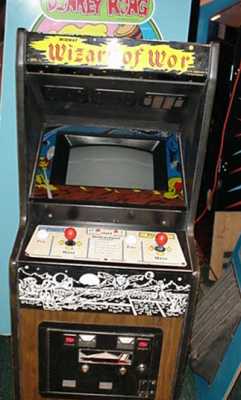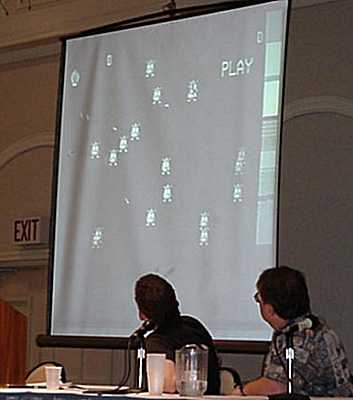9:30 am Saturday Panel Discussion
John Seghers, Steve Woita, Rob Newman, Bob Polaro

John Seghers
John was one of the top programmers for the Atari 5200 game system. In addition to the fantastic Gremlins (arguably the best game made for the system), John also designed RealSports Soccer and the completed by never released Xari Arena. John created several development tools as well including a four voice, touch pad controlled music editor. After Atari, John worked on the NES version of Indiana Jones and the Last Crusade for Taito Software.
John answered a question about why were the 5600 controllers so flimsy. Apparently Atari knew that the controllers break because a head engineer took the controllers home to allow his kids to test them. They broke within weeks. The plastic for the controllers had already been cast. The head guy held a patent on the design and had the authority to approve the product.
Some of John's favorite games are Qix, Gravitar, and Tempest.
Steve Woita
Steve started at Apple where he co-designed a device called the JOYPORT wich was licensed by Sirius. The Joyport allowed 4 game paddles and 2 Atari controllers to be hooked up to an Apple II. Steve later went to Atari where he designed three games for the VCS: Quadrun (the first home videogame with voice that didn't require extra hardware), Taz, and Asterix. After Atari, Steve did more contract work for Apple before going to Tengen to create Super Sprint for the NES.
The panel was asked if there were any games they wished they had designed. Steve said Stampede. One of Steve's favorite games is Demon Attack.
Was there any competition between the programmers? Steve said that there was some competition. Rob Newman said that once royalties got involved, it became much more competitive.
Rob Newman
An Engineer in Atari's L.A. lab, Rob was instrumental in the development of wireless data distribution technology which led to his becoming a founding manager of Electronic Publishing Systems (EPS), a joint venture of Atari and Activision in late 1983. EPS developed the "Electronic Pipeline", a game service for the Atari 2600 that was to sell wireless game cartridges with which users could select and play up to 40 different games each month for a low monthly subscription fee. The service was in alpha testing and four days form installing the transmission equipment in the first test market when it was indefinitely postponed due to Warner's sale of Atari in 1984.
Rob was asked when was the last time he had played one of his games. He said he showed Demon Attack to his niece. She played it for 10 seconds and said it was stupid.
Rob said he started with Atari and wrote Superman with paper and pencil. The programmers would turn in the code to women who would type it in and convert it to paper tape. The games would take 5 minutes to compile on a PDP11. The code was only 4k. When asked about source code control, all the audience was treated to was a big smile and laugh.
Bob Polaro
Bob's game career started with Commodore where he designed the PET titles, Baseball, Stock Portfolio, and Blackjack. He jumped to Atari and released States and Capitals, Hangman, Biorhythm, Lemonade Stand, and Mugwump for the Atari 8-bit computers. Bob really hit gold when he moved into 2600 development with such unforgettable titles as Defender, RealSports Volleyball, Desert Falcon, SprintMaster and Road Runner. He also designed the 2600 version of Rampage for Activision.
Bob was pretty quiet during the panel discussion. He did say that his favorite title still remains Missile Command.
11:00 am Saturday Panel Discussion
Jamie Fenton, Franz Lanzinger, Susan McBride

Jamie Fenton
At Bally, Jamie designed the classic pinball game, Fireball, which was designed for home use. She later went on to design the Bally Astrocade and the Bally Basic Interpreter. Her arcade achievements are numerous including such classics as Gorf and Robby Roto. Jamie then formed Macromind and coded the fantasic MacroMedia Director.

Wizard of Wor, one of Jamie's hits
Jamie started working for Dave Nutting Associates (DNA) as an industrial designer. She worked on several pinball games such as 1776. She also worked on Fireball, which was a home pinball machine. Jamie worked on one of the earliest video arcade games, Wizard of Wor. She went on to show a video diary she kept while coding Ms. Gorf, which was a knock off of the Star Trek movie. The game is currently lost, as no hardware exists which can play it, but there are some pictures of it on tape, which we got to see.

A screenshot of the "lost" game Ms. Gorf, which was intended as a sequel to the classic Gorf. The play of this level was a bit like Robotron, as you had to move and shoot simultaneously to wipe out the Gorfs. One particularly cute feature shown later was the "Clone Machine". It would drift around the screen, and if a Gorf entered it, two would pop out the other side!

Gorf, the original
Franz Lanzinger
Franz worked as a programmer and game designer at Atari Games, Inc. and Tengen. Early on in his career he programmed and designed the groundbreaking arcade hit, Crystal Castles. A terrific video game player himself, Franz even held the world record for the arcade version of Centipede for six months in 1981. At Tengen, Franz worked on Toobin' and Ms. Pacman for the NES, and Genesis and Rampart for the NES, SNES.
Franz talked about how initially a project would be assigned one programmer and one artist for each title. The number of artists grew to five animators per project.
Susan McBride
Susan is a graphic artist who was with Atari for many years. After sharpening her skills on the arcade smash hits, Crystal Castles, Gauntlet, Gauntlet 2, and other Atari coin-ops, she moved on to work on numerous Atari Lynx and Jaguar projects.
Susan was initially a film animator and was referred to Atari by her professors at film school. She had a student film called Muncha Muncha and featured a small character which was essentially a precursor to Pac-man.
Susan answered the question regarding what she considers a classic game. She considers a game a classic if the game is still played 10 to 20 years later.
Susan also said that the development cycles differ between the arcade games and home entertainment games. The arcade games require more robust hardware and therefore have a longer development cycle.

The Museum
|